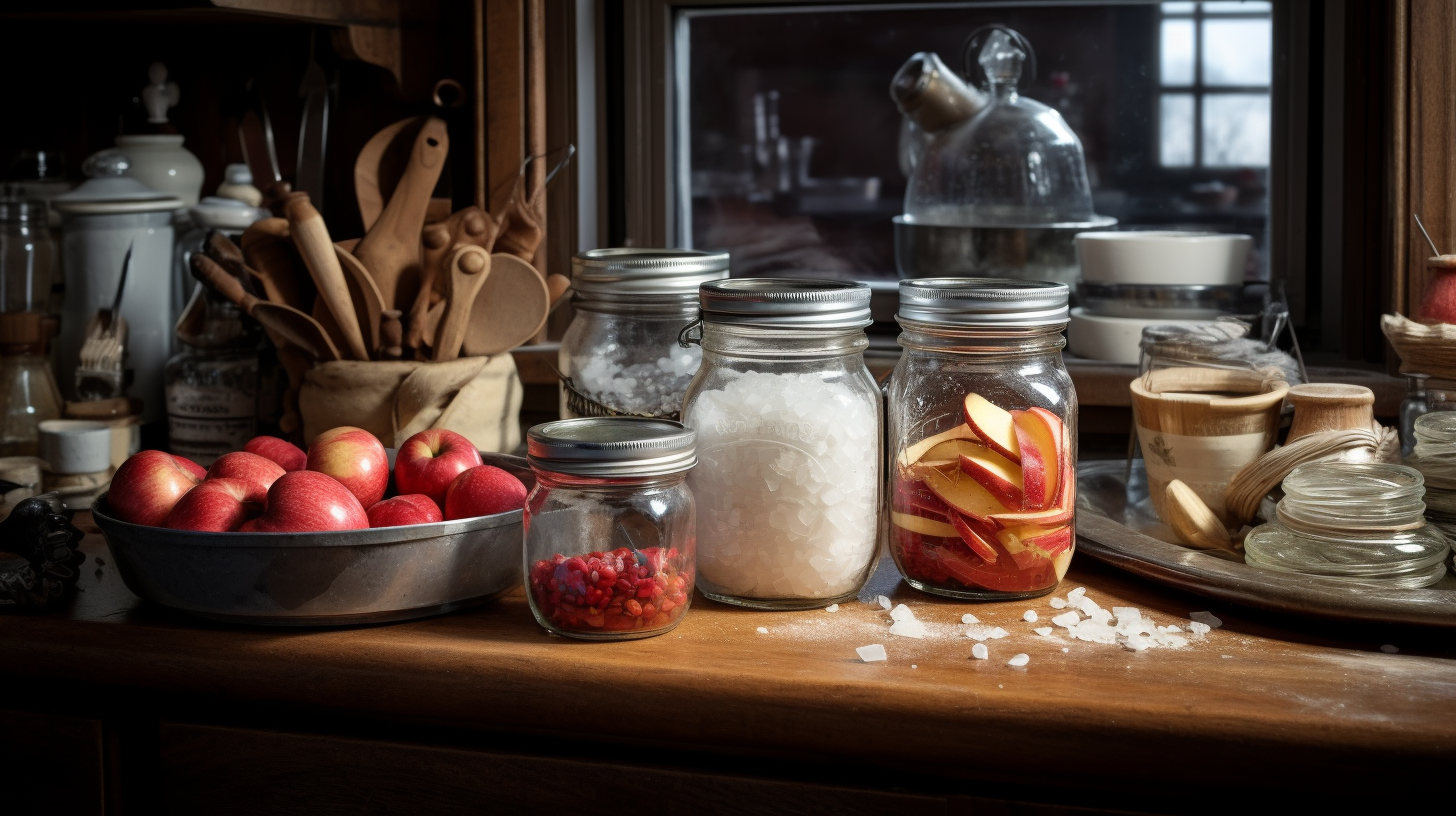Did you know that nearly 90% of American households purchase applesauce, but only a fraction of that number make their own?
You’re about to join that exclusive club by mastering the art of freezing your homemade applesauce. First, you’ll need to ensure that your apples are peeled, cored, and cooked down to the perfect consistency, with just the right balance of sweetness and tartness.
Once you’ve achieved your desired flavor, allow the applesauce to cool. You’ll then portion it into airtight, freezer-safe containers or bags, leaving enough headspace to accommodate expansion as the sauce freezes.
This process, while straightforward, contains nuances that can make or break the quality of your preserved applesauce. As you prepare to secure the fruits of your labor for months to come, consider the variables that could affect texture and taste upon thawing—variables that we will explore to ensure your applesauce remains as delightful as the day you made it.
Key Takeaways
- McIntosh and Golden Delicious are popular apple varieties for applesauce, with McIntosh resulting in a creamier sauce and Golden Delicious creating a slightly chunkier sauce.
- Peel, core, and cut apples into uniform chunks for even cooking, and cook them with water to prevent sticking and burning.
- Consider adding traditional spices like cinnamon and nutmeg, or experiment with allspice or ginger, to enhance the flavor of the applesauce.
- Select rigid plastic containers with tight-fitting lids or heavy-duty freezer bags for packaging, leaving half an inch of space at the top to accommodate expansion during freezing. Label containers clearly with contents and date of freezing for easy organization.
Selecting the Right Apples
Choosing the right apples often dictates the quality and flavor of your homemade applesauce. You’ll want to consider apple varieties carefully, as each type brings its own unique flavor profiles to your sauce.
For a traditional and richly flavored applesauce, you can’t go wrong with McIntosh or Golden Delicious—both are time-honored choices known for their balance of sweetness and tartness as well as their smooth texture when cooked down.
To dive into the specifics, McIntosh apples break down easily during cooking, which means you’ll be rewarded with a creamier applesauce. They’re ideal if you prefer a smoother consistency with a hint of tartness.
On the other hand, Golden Delicious apples maintain a bit more structure, offering a slightly chunkier sauce with a milder, sweet taste.
When selecting apples, be methodical. Look for fruits that are firm to the touch and free of bruises. Remember, a mix of apple varieties can provide a more complex flavor profile. Consider adding a few Granny Smiths for a tangy kick or Rome apples for a hint of spice.
Ultimately, your choice of apples will lay the foundation for a deliciously traditional homemade applesauce that’s perfect for freezing and enjoying any time of year.
Preparing the Applesauce
Having selected the ideal mix of apples for your desired flavor balance, it’s time to focus on making the applesauce, ensuring each step is executed with care for the best results. Start by peeling, coring, and cutting your apples into uniform chunks. This promotes even cooking and contributes to a consistent applesauce consistency.
Next, place the apple pieces into a large pot and add just enough water to cover the bottom—this prevents sticking and burning. Cook the apples over medium heat, stirring occasionally, until they become soft and mushy. Depending on your preference for texture, you can use a potato masher for a chunkier sauce or an immersion blender for a smoother consistency.
Now’s the time to consider spice variations. Traditional spices include cinnamon and nutmeg, but don’t hesitate to experiment with others like allspice or ginger for a unique twist.
| Step | Detail |
|---|---|
| Peel, Core, and Cut | Ensure uniform chunks for even cooking |
| Cook with Water | Prevent sticking, softening the apples |
| Mash or Blend | Achieve desired applesauce consistency |
| Add Spices | Customize with spice variations |
Packaging for Freezing
Once your applesauce is ready, you’ll need to properly package it for freezing to ensure its freshness and flavor are preserved. Here’s a detailed, methodical approach to packaging:
- Select the Right Container: Your container choices are crucial for maintaining the quality of your applesauce. Rigid plastic containers with tight-fitting lids are ideal as they’re less likely to crack at low temperatures. Alternatively, you can use heavy-duty freezer bags, which save space but may be prone to leaks if not sealed correctly.
- Leave Room for Expansion: When filling your chosen containers, leave about half an inch of space at the top. As the applesauce freezes, it will expand, and this space allows for that expansion without causing the container to crack or the lid to pop off.
- Label Clearly: Employ effective labeling methods to keep track of your applesauce. Use freezer-safe labels or masking tape and a permanent marker to note the contents and the date of freezing. This step is traditional yet essential, as it helps you rotate your stock and use the oldest batches first, ensuring nothing goes to waste.
Freezing and Storage Tips
To ensure your homemade applesauce retains its quality during freezing, adhere to these detailed storage guidelines. Portion control is crucial; it’s not just about convenience, but also about maintaining the integrity of your applesauce. When you freeze in the right quantities, you’ll avoid waste and preserve the texture and flavor. Consider how much applesauce you typically use at one time and divide it into those portions before freezing.
Container choice is equally important. Opt for airtight, freezer-safe containers or bags. They should be durable, easy to label, and suitable for the volume of applesauce you’re storing. Remember, liquids expand when frozen, so leave a little headspace in each container to accommodate this.
Here’s a table to evoke the care and attention you’re putting into preserving your homemade creation:
| Portion Size | Emotional Benefit |
|---|---|
| Single Serve | Cozy Convenience |
| Family Batch | Shared Traditions |
| Small Jars | Personal Touch |
| Freezer Bags | Flexible Use |
| Large Tubs | Generous Hosting |
Be methodical in your approach: label each container with the date and contents, and organize your freezer to cycle through older portions first. With these traditional practices, you’ll enjoy your applesauce as if it were made fresh, any time of the year.
Thawing for Best Flavor
When you’re ready to enjoy your frozen homemade applesauce, defrosting it correctly is essential to preserve its homemade flavor and texture. Thawing gently is the key to flavor preservation, ensuring that the subtle nuances of your carefully prepared applesauce aren’t lost. Here’s how to do it:
- Refrigerator Thawing: Transfer your frozen applesauce from the freezer to the refrigerator at least 24 hours before you plan to consume it. This slow thawing process is the most traditional method and helps maintain the taste and consistency that you love.
- Cold Water Bath: For a quicker option, place the sealed container of applesauce in a cold water bath. Change the water every 30 minutes to continue thawing evenly. This method is methodical, preventing the applesauce from reaching temperatures that could deteriorate its flavor.
- Reheating Methods: If you prefer your applesauce warm, you can reheat it after it’s thawed. Do this over low heat on the stove, stirring frequently to avoid burning. Alternatively, use a microwave, heating in short bursts and stirring in between to distribute the warmth evenly without compromising the applesauce’s homemade quality.

